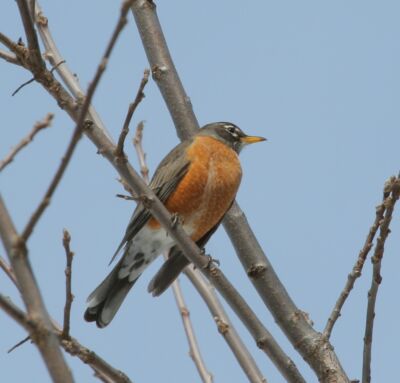Robins – the Harbingers of Spring
It happens every year – someone happily announces that they saw their “first spring robin.” For many, the American Robin is considered to be a harbinger of spring; a joyous sign that warmer days are just ahead. Winter sightings of robins are much less common, leading many to assume they are absent.
So it’s understandable when people are confused and concerned when they see a robin in the middle of January. Did this bird forget to migrate south? The answer is both yes and no.
Although some robins fly south to avoid winter, many remain in southern Ontario the entire year. Rather than relocating, they simply change their behaviour in the colder months and often go unnoticed.
The birds that make the journey south are not lured by warmer temperatures. Robins can withstand extreme cold as their warm, downy feathers insulate them from blowing wind and snow. Their wintering range is affected by the scarcity of food rather than cold temperatures. As long as food is available, these birds are able to stay.
In August, robin populations appear to drop, but this does not mean that they have migrated south. Instead, there is a shift in their distribution. During the spring and summer, most of their diet is made up of invertebrates. As fall approaches and their warm-weather diet of earthworms and insects wanes, robins begin searching for other food sources, with fruit making up more than 90% of their winter diet.
At this time, their lifestyle also changes. In the spring and summer, robins aggressively defend their territory while raising their young. During the winter, they are non-territorial and nomadic as they move around in search of food. Instead of inhabiting back yards, they now travel in flocks and congregate in local wildlife refuges where there is a source of nourishment. Flocking offers critical benefits. Larger groups mean more eyes to spot and avoid predators and increase the odds of discovering food.
As weather varies from year to year, the amount of wild fruit available can change dramatically. Thus, robins stay north if there is plenty of food, or move south if the supply diminishes. Due to climate change, robins are spending more time in the north as milder winters mean more available food. The birds remain mostly out of sight as they feast on the berries of dogwoods, junipers, crabapples, winterberries, and wild grapes. A flock will strip a tree or shrub of its fruit within hours, and then move on.

Another reason we associate robins with spring is that they seem to show up with the warm weather and start warbling their familiar song. To defend their territory, robins enthusiastically sing when they arrive on their breeding grounds. They are often the first birds to begin singing in the morning and one of the last heard at night. Males generally arrive on territory two weeks before the females and are more vocal, especially during courtship. In contrast, they make very little noise during the winter months, which helps explain how flocks can go largely unnoticed.
Gender also plays a role in determining whether an individual stays. In northern areas, males are more likely to remain than females. This offers territorial advantages, allowing the males who overwinter earlier access to the best breeding ground.
When spring arrives, the flock disperses. There is a switch from being non-territorial, mostly silent and out of sight, to aggressively defending a breeding territory and highly visible and audible. Suddenly, yards and parks are alive with robins looking for worms, and it is easy to assume they have just returned from southern climates. Either way, when they arrive back into our gardens it is a joyful awakening.
Contact: Brenda Gallagher, Forestry Technician

